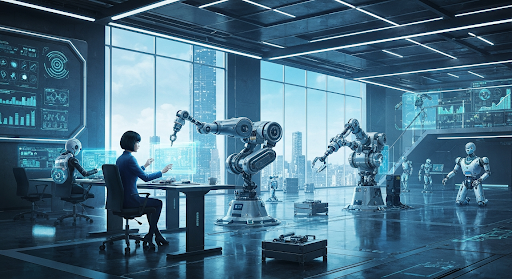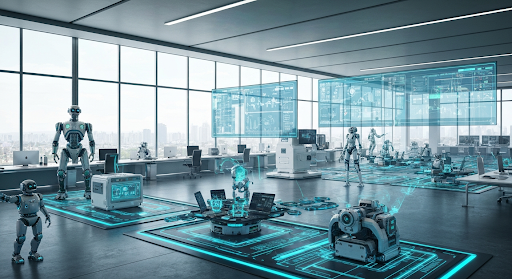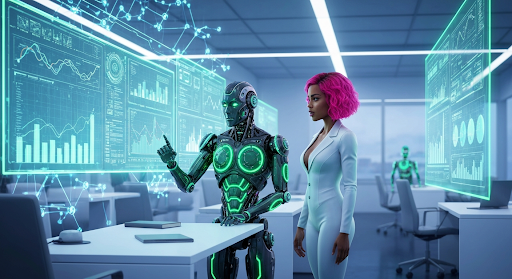Robots Automation vs. Traditional Methods: Key Differences
Key Highlights
- Robots automation relies on programmable machines and artificial intelligence to handle repetitive, complex tasks, while traditional methods depend on manual processes and direct human intervention.
- Automation technology boosts efficiency, minimizes human error, and offers significant cost savings compared to conventional practices.
- Robotic process automation (RPA) and intelligent automation are transforming business processes and daily workflows through digital transformation.
- The adoption of robotics is reshaping workplace roles, freeing human workers to focus on strategic and creative activities.
- Real-world applications span manufacturing, logistics, healthcare, and more, with both benefits and challenges impacting industry trends today.
Introduction
The rise of robot automation and advanced automation technology has sparked a major shift in how businesses operate compared to traditional methods. Tasks once performed by human hands are now often handled by machines or software, leading to faster and more precise outputs. As companies aim for greater productivity and reliability, understanding the differences between robot automation and traditional methods becomes essential. This guide explores how automation is reshaping industries and what it means for those still relying on manual practices.
Defining Robots Automation and Traditional Methods
Robots automation involves utilizing programmable machines to perform tasks automatically, often without direct human involvement. This automation process combines physical hardware with intelligent software, empowering robots to execute jobs with high accuracy and speed. Whether applied in factories or offices, robots automation leverages advanced technologies like artificial intelligence to optimize workflows.
On the other hand, traditional methods rely heavily on human labor, manual processes, and step-by-step oversight. Tasks are completed through direct human effort, making them more susceptible to error and inconsistency. The contrast between these approaches sets the stage for a deeper dive into their defining features.
What Are Robots and How Is Automation Applied?
Robots are programmable machines engineered to carry out tasks that range from simple to highly complex, often with little or no human input. Industrial robots, for example, dominate manufacturing by assembling products, welding, or managing materials on production lines. These robots operate using advanced automation systems that integrate sensors, actuators, and control software to ensure seamless performance.
Automation, as a broader concept, refers to using technology—whether software or hardware—to handle repetitive assignments and minimize human intervention. Robotics is a specialized branch within automation, focusing specifically on deploying physical robots for process automation. Software automation, meanwhile, addresses digital tasks without needing physical robots.
In industry, robotics and automation systems are used together or separately based on project needs. Robotics brings automation into the physical world, while automation itself can function purely with software. The integration of artificial intelligence amplifies both, making machinery and software smarter and more adaptable to changing demands.
Key Characteristics of Traditional Methods
Traditional methods are distinguished by their reliance on human workers and manual processes. Every step of the workflow often demands direct human intervention, requiring people to perform, monitor, and correct tasks as needed. This approach can limit process efficiency, especially in environments where speed and consistency are vital.
Manual processes present several characteristics:
- Tasks are performed by human workers, increasing the risk of fatigue and human error.
- Consistency and quality may fluctuate, as results depend on individual skill and attention.
- Scaling up production requires hiring and training additional staff, rather than upgrading equipment.
- Adapting to new products or workflows is often slow and resource-intensive.
While traditional methods offer control and hands-on oversight, they inherently lack the speed, repeatability, and data-driven insights provided by modern automation solutions.
Major Differences Between Robots Automation and Traditional Practices
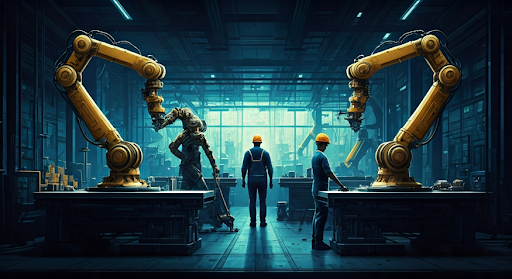
When comparing robot automation with traditional practices, the contrasts are striking. Robot automation employs automation software and programmable machines to carry out tasks with precision and speed, reducing the need for constant human oversight. Traditional practices, in contrast, rely on people to execute each step, making them less consistent and more prone to inefficiency.
The automation process streamlines workflows and allows for easier scaling, while traditional practices tend to struggle with volume and complexity. Next, we'll look more closely at how technology, workflow, and adaptability further set these approaches apart.
Technology, Workflow, and Adaptability
Technological advancements have profoundly changed how work gets done. Automation technology now includes powerful robotics, intelligent software, and integrated systems, all designed to enhance workflow efficiency and flexibility. This shift toward digital transformation has revolutionized production environments, enabling businesses to adapt quickly to market needs.
Today’s robots and automation systems are much more flexible than their predecessors. They can be reprogrammed or even learn new tasks through artificial intelligence, supporting dynamic workflows and customization on the fly. Traditional methods, by contrast, often struggle to adjust quickly and require significant resources to pivot.
| Feature | Robots Automation | Traditional Methods |
|---|---|---|
| Technology | Advanced automation systems, AI, sensors | Manual tools, limited tech use |
| Workflow | Streamlined, continuous, data-driven | Step-by-step, human-dependent |
| Adaptability | Highly flexible, easy to reprogram | Rigid, slow to change |
| Product Environment | Digital, scalable | Labor-intensive, less scalable |
Efficiency, Accuracy, and Cost Differences
Efficiency gains are among the most talked-about advantages of robot automation. Automated systems can run around the clock, delivering consistent results and dramatically reducing human error. The use of automation software and physical robots leads to quicker production cycles, enabling companies to deliver more in less time.
Key benefits include:
- Enhanced efficiency and output consistency compared to manual labor
- Significant reduction in human error, boosting product quality
- Lower operational costs and greater cost savings over time
- Scalability—easily increase capacity without major hiring sprees
- RPA bots free up employees for complex and value-driven tasks
However, adopting robots and automation in manufacturing is not without challenges. Upfront investment is high, and implementation can require specialized training and integration. Yet, the long-term savings, improved safety, and workforce satisfaction often far outweigh initial hurdles.
Types of Automation and Robots Used in Industry
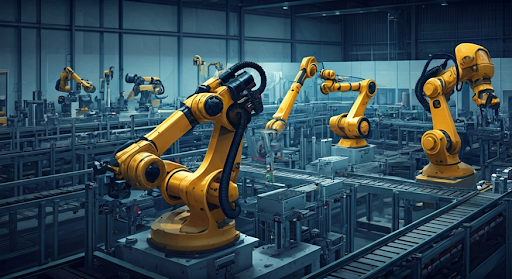
Different types of automation and robots are in operation across industries today. Industrial robotics is commonly found on the production line, automating tasks such as welding, packaging, and assembly. These systems are essential for achieving high-volume, repeatable output with minimal error.
Collaborative robots, also known as cobots, and a range of automation technologies are transforming how humans and machines work together. As automation becomes more advanced, companies are adopting flexible solutions to meet evolving production demands and ensure greater workplace safety.
Industrial Robots vs. Collaborative Robots (Cobots)
In manufacturing, a clear distinction exists between industrial robots and collaborative robots, or cobots. Industrial robots excel in high-volume production environments, handling repetitive tasks with speed and precision, ultimately reducing human error. In contrast, cobots are designed to work alongside human workers, enhancing safety and flexibility in workflows. This intelligent automation fosters employee satisfaction while allowing businesses to adapt to complex tasks. Each type plays a crucial role in the overall landscape of automation systems, contributing to digital transformation efforts across industries.
Robotic Process Automation (RPA): Software Solutions
Robotic Process Automation (RPA) revolutionizes how businesses streamline operations through intelligent automation. By deploying software bots, organizations can automate repetitive tasks that once required significant human intervention, thus minimizing human error and enhancing efficiency. Benefits of RPA include improved employee satisfaction and competitive edge by reallocating human workers to complex tasks. In the realm of financial services, RPA software plays a vital role, enabling faster processing of transactions while leveraging machine learning and process mining to optimize operations and ensure digital transformation.
Real-World Applications and Industry Examples
Across industries, automation technology is driving real, measurable results. In manufacturing, robots assemble products and perform inspections, while automation in warehouses optimizes inventory management. The production environment has become more dynamic, thanks to innovations that streamline workflows and improve safety.
Use cases extend far beyond factories. Logistics, healthcare, agriculture, and even customer service benefit from implementing robotics and automation. These examples reveal the growing capabilities and impact of automation on business efficiency and workforce roles.
Manufacturing, Warehousing, and Logistics Innovations
In manufacturing, robots handle assembly, welding, and quality control, working faster and more accurately than humans. Warehousing and logistics have embraced automation with autonomous mobile robots and computer vision systems that sort, pick, and move products with minimal human intervention. These innovations streamline the entire supply chain.
Examples of automation in action:
- Autonomous mobile robots navigate warehouses to transport goods efficiently.
- Computer vision enables robots to inspect products for quality flaws.
- Automated guided vehicles manage inventory and order fulfillment.
- RPA optimizes scheduling, inventory tracking, and shipping.
- Manufacturing robots can work around the clock, boosting productivity.
According to Jeff Burnstein, president of the Association for Advancing Automation, "Automation has become the key enabler for companies seeking to thrive in a highly competitive environment."
Impact on Workforce and Job Roles
Introducing robots and automation technology has shifted the nature of work across many industries. While some fear job loss, the reality is more nuanced—automation tends to change job roles rather than eliminate them. Repetitive and hazardous tasks are now performed by machines, allowing human workers to move into more creative, analytical, or supervisory positions.
Key impacts include:
- Increased employee satisfaction as workers shift from manual to strategic roles
- New job opportunities in programming, maintaining, and optimizing robots
- Enhanced workplace safety by reducing human exposure to dangerous tasks
- The need for ongoing training as digital transformation continues
As "automation supports and enhances human work, rather than replacing it entirely," noted robotics thought leader Evan Beard, the future workforce will require a blend of technical and problem-solving skills.
Conclusion
In conclusion, understanding the key differences between robots automation and traditional methods is crucial for any business looking to enhance efficiency and productivity. As industries continue to evolve, embracing automation technologies can lead to significant improvements in workflow, accuracy, and cost-effectiveness. However, it's essential to weigh the benefits against potential challenges to make informed decisions. By integrating the right automation tools, businesses can not only streamline operations but also adapt to changing market demands. If you're ready to explore how robots automation can transform your processes, reach out for a consultation today!
Frequently Asked Questions
What are the main benefits and challenges of robot automation?
Robot automation brings major efficiency gains, reduced human error, and cost savings through the benefits of RPA. Challenges include high initial investment and integration complexity. Over time, the automation process helps businesses streamline workflows and improve quality, but it requires careful planning and skilled oversight.
How do businesses develop a successful robots automation strategy?
A successful robots automation strategy starts with process mining to identify automation opportunities. Companies should focus on scalable RPA implementations, continuous training, and integration with existing systems. This approach maximizes efficiency, secures a competitive edge, and ensures long-term ROI.
What is the current state and future outlook for robots automation?
Robots automation continues to expand rapidly in the United States and globally. Intelligent process automation is driving digital transformation across sectors. The future outlook includes smarter, more adaptable robots and greater collaboration between humans and machines, fostering new roles and business models.

